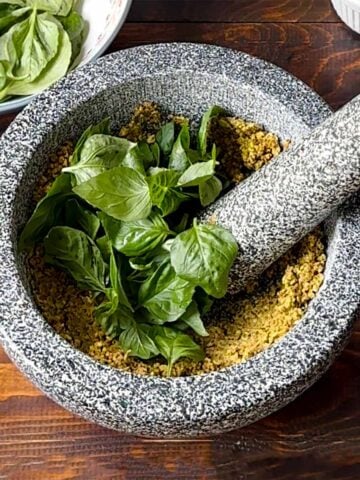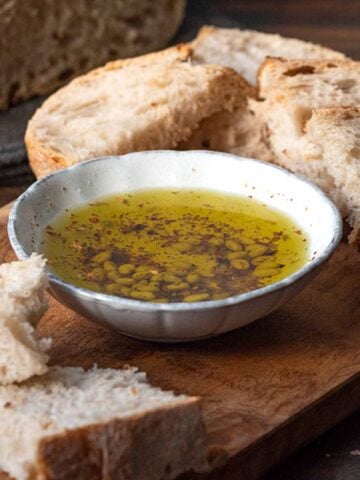Learn how to make almond butter (raw or roasted) with just almonds and a few optional ingredients for the best taste!
It's a healthy snack everyone loves and can be used in many recipes (list below)

This healthy homemade almond butter is my latest obsession. You can make it either with raw or roasted almonds, but roasted have so much more flavor!
I love it even more than peanut butter and my favorite (and simple) way of enjoying it is by mixing it with some honey and slathering it on toasted bread. When I feel fancy I grate some dark chocolate on top. It's the best snack ever! If you're searching for recipes with almond butter, I have a short list at the end of this post. And if you love sweet spreads, don't miss this easy 2-ingredient pistachio cream!
Homemade almond butter is easier than you think (certainly easier than making your own tahini) and cheaper than the store-bought stuff because it will cost you just as much as buying raw almonds.
The process for making almond butter at home is similar to peanut butter (I have a short video for homemade peanut butter in my Instagram highlights) but you’ll probably need just a little bit more time because almonds are tougher.

Keep in mind that if you follow a vegan, paleo or keto diet, you may want to consider adding this to some of your recipes, either for creaminess, extra taste, or for more protein and healthy fats.
How to make it
Step 1.
First, you have to decide if you want to make raw almond butter or almond butter from roasted almonds. The biggest difference is the taste. Roasted almonds have more intense, almost addictive taste while the raw ones taste more mild.
Both have the same calories and the same nutrients (an insignificant amount of some nutrients may be destroyed during baking). You can read more in this article about raw vs roasted almonds from livestrong.com.
Step 2.
You can use almonds with or without the skin (blanched). The skin of the almonds is not bitter like the skin of hazelnuts, and it can also add some more fiber (plus it makes the color of the almond butter better in my opinion)
I would advise you to choose blanched almonds if you happen to have digestive problems, because almond butter from blanched almonds will be more digestible.
Buy raw almonds and roast them in the oven yourself. Warm almonds blend more easily and offer maximum fresh almond flavor. Roasting the almonds only takes 10-15 minutes, and it’s absolutely worth it.
Step 3.
Process in a food processor. A heavy duty blender with a tamper may also work but when the almonds become paste, the paste can stuck on the walls of the bowl and not blend.
Remember, patience is key. It might seem like the almonds will never turn into a creamy nut butter but if you persist they will do. You will probably need 20 – 25 minutes.
If your food processor is not a heavy duty one, remember to let it rest for 2-3 minutes after every 10 minutes of continuous operation.

Step 4.
Transfer to a jar and store in a cool, dry place.
Nutrition Facts
Like all nut butters, almond butter contains a lot of healthy, unsaturated fat and a small amount of saturated fat. It also contains a lot of vitamins and minerals like calcium, manganese, potassium, magnesium, iron and a lot of vitamin E. One tablespoon (16 grams) of plain almond butter contains:
- 101 calories
- 3.4 grams of protein
- 3,4 grams of carbohydrates
- 9,5 grams of fat and
- 1.6 grams of fiber
Is almond butter healthier than peanut butter?
If you want to be very strict, yes almond butter is healthier than peanut butter. But their differences are so small that it doesn't really make much of a difference.
Specifically, almond butter has about the same calories as peanut butter, but it contains more healthy fats, nearly three times as much vitamin E, twice as much iron, twice the fiber and seven times more calcium.
Peanut butter has a little bit more protein. Given the fact that peanut butter is cheaper, you don't have to rush and replace it for something slightly healthier.
But if you love the taste of almonds (like I do) then you should definitely make it at least once. It will become one of your favorite snacks.

Recipes with almond butter
If you're looking for recipe ideas using almond butter, some of the following can be a great inspiration:
- 5-ingredient flour-less chocolate cake
- Chocolate truffle energy balls
- No-churn roasted almond and white chocolate ice cream
- Almond butter and peach jam sandwiches
- Sugar-free banana popsicles with peanut or almond butter
- Replace the tahini with almond butter in this olive oil and tahini chocolate chunk cookies.
- Make a sweet almond spread to slather on bread: mix 2 tablespoons almond butter with 1 teaspoon honey until a thick paste is formed. Spread on a thick slice of bread and top with some grated dark chocolate.
- Add it to smoothies and smoothie bowls for extra protein.
- Spread it on fresh fruit like apples, pears, bananas.
- Make these almond butter cups from pinch of yum.
- Make these flourless Almond Butter Chocolate Chip Cookies from Sally's baking addiction.
- This Chicken Satay with Lighter Almond Dipping Sauce from Foodie Crush also sounds delicious!

Storage
Does almond butter need to be refrigerated? No, it will keep well stored in a cool dry place for at least one month. The only exception is if you live in a very warm place – in that case I would keep it in the fridge just to be sure.
I like to store my homemade almond butter in my kitchen cupboard and I only transfer it in the refrigerator during the hot summer months.
When stored in a well sealed glass jar it will last at least 4 weeks (I've had it for more weeks without any problems).
If you notice some oil forming at the surface (this is normal), give it a good stir with a fork and it will be perfect again.
🎥Recipe Video
📖 Recipe

How to make almond butter
Ingredients
- 2 cups (320 grams) raw almonds
- A pinch of salt
- A pinch of cinnamon ((optional))
- 1-2 tablespoons neutral flavor vegetable oil ((optional))
Instructions
- Preheat your oven at 350 °F (175 °C )
- Transfer the almonds to a baking pan, spread them in one layer and bake for 15-20 minutes (the longer you bake them the more intense their flavor will be, but be careful not to burn them).
- Let the almonds cool for 5 minutes and transfer them into the bowl of your food processor. Add the salt and the cinnamon and process for 10 minutes (you may have to stop and scrape the bowl a few times).Add 1 tablespoon oil and continue to process until completely smooth (this is optional but it helps if your food processor is not strong enough). Add the second tablespoon of vegetable oil if your almond butter is still having difficulty becoming very smooth.
- Transfer to a jar and store in a cool, dry place.
Notes
- The given quantities will give you 1 ¼ cups almond butter. You can double the recipe for more. Serving size: 1 tablespoon.
- The almonds can be with or without the skin. If you leave the skin on, the color of the almond butter will be darker.
- Roasting the almonds is optional but it makes the almond butter much more flavorful. Even if you don't want them roasted, I recommend warming them briefly in the oven because this will help them blend better and faster.
- Turn off your food processor for a few minutes half-way through the procedure to let it rest and cool down (especially if it's getting hot).
- All natural nut butters will form a thin layer of oil on their surface after a while. Stir well with a spoon until homogenized again.
Nutrition








Maria says
Very nice recipe, toasting the almonds really makes all the difference!
Makos says
It does! 🙂